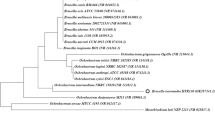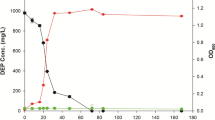Abstract
Two bacterial isolates (Pseudomonas sp. GSa and Pseudomonas sp. GSb) were in close association able to assimilate 2,4 dichlorobiphenyl (2,4 CB), a PCB congener. GC–MS analysis of spent culture medium of the consortium with 2,4 CB as substrate showed 90 % degradation (according to Electron capture detection values) with catechol as one of the important intermediate compounds through meta-cleavage pathway. Further, ability of the consortium to utilise PCB congeners, Methoxychlor, Aroclor 1016, Chlorobenzoic acids and Monoaromatic compounds indicated that the consortium of GSa and GSb would be an ideal candidate for in situ bioremediation of PCB.



Similar content being viewed by others
References
Adriaens P, Kohler HP, Kohler SD, Focht DD (1989) Bacterial dehalogenation of chlorobenzoates and coculture biodegradation of 4,4′-dichlorobiphenyl. Appl Environ Microbiol 55:887–892
Arensdorf JJ, Focht DD (1994) Formation of chlorocatechol meta cleavage products by a pseudomonad during metabolism of monochlorobiphenyls. Appl Environ Microbiol 60:2884–2889
Bevenakatti BG, Ninnekar HZ (1993) Biodegradation of 4-Chlorobiphenyl by Micrococcus species. World J Microbiol Biotechnol 9:607–608
Blasco R, Wittich RM, Mallavarapu M, Timmis KN, Pieper DH (1995) From xenobiotic to antibiotic, formation of protoanemonin from 4-chlorocatechol by enzymes of the 3-oxoadipate pathway. J Biol Chem 270:29229–29235
Commandeur LCM, May R, Mokross H, Bedard DL, Reineke Govers HAJ, Parsons JR (1996) Aerobic degradation of polychlorinated biphenyls by Alcaligenes sp. JBI: metabolites and enzymes. Biodegradation 7:435–443
Crawford RL, Hers TF, Paszczynski A (2004) Combined biological and abiological degradation of xenobiotic compounds. Biodegrad Bioremediat Soil Biol 2:251–278
Dai S, Vaillancourt FH, Maaroufi H, Drouin NM, Neau DB, Snieckus V, Bolin JT, Eltis LD (2002) Identification and analysis of bottleneck in PCB biodegradation. Nat Struct Biol 9:934–939
Faroon O, Keith L, Smith-Simon C, De Rosa C (2003) Polychlorinated biphenyls. Human health aspects In Concise international chemical assessment document 55. World Health Organisation Geneva. Inc 432-435
Fava F, Di Gioia D, Cinti S, Marchetti L, Quattroni G (1994) Degradation and dechlorination of low-chlorinated biphenyls by a three–membered bacterial coculture. Appl Microbiol Biotechnol 41:117–123
Fetzner S, Lingens F (1994) Bacterial dehalogenases: biochemistry, genetics, and biotechnological applications. Microbiol Reviews 58:641–685
Furukawa K, Chakrabarthy AM (1982) Involvement of plasmids in total degradation of polychlorinated biphenyls. Appl Environ Microbiol 44:619–626
Furukawa K (2006) Oxygenases and dehalogenases molecular approaches to efficient degradation of chlorinated environmental pollutants. Biosci Biotechnol Biochem 70:2335–2348
Greenberg AE, Clesceri LS, Eaton AD (1992) Standard Methods for the Examination of Water and Wastewater, 18th edn. APHA, Washington
Ibanez JG, Hernandez-Esparza M, Doria-Serrano C, Fregoso-Infante A, Singh MM (2007) Environmental chemistry: fundamentals. Springer, New York
Komancova M, Jurcova I, Kochankova L, Burkhard J (2003) Metabolic pathways of polychlorinated biphenyls degradation by Pseudomonas sp. 2. Chemosphere 50:537–543
Maltseva OV, Tsoi TV, Quensen JF III, Fukuda M, Tiedje JM (1999) Degradation of anaerobic reductive dechlorination products of Aroclor 1242 by four aerobic bacteria. Biodegradation 10:363–371
Marcin S, Stanislaw K (1999) Habitat conditions of nymphaeid associations in Poland. Hydrobiologia 415:177–185
Martinez P, Agullo L, Hernandez M, Seeger M (2007) Chlorobenzoate inhibits growthand induces stess proteins in the PCB—degrading strain Burkholderia xenovarans LB400. Arch Microbiol 188:289–297
Piper DH (2005) Aerobic degradation of polychlorinated biphenyls. Appl Microbiol Biotechnol 67:170–191
Potrawfke T, Lohnert TH, Timmis KN, Wittich RM (1998) Mineralization of low- chlorinated biphenyls by Burkholderiasp. Strain LB400 and by a two-membered consortium upon directed interspecies transfer of chlorocatechol pathway genes. Appl Microbial Biotech 50:440–446
Powlowski J, Shingler V (1994) Genetics and biochemistry of phenol degradation by Pseudomonas sp CF 600. Biodegradation 5:219–236
Robinson GK, Lenn MJ (1994) The bioremediation of polychlorinated biphenyls (PCBs): problems and perspectives. Biotechnol Gen Eng Rev 12:139–188
Zak S (2006) Detection of meta-and ortho-cleavage dioxygenases in bacterial phenol- degraders. J Appl Sci Environ 10:75–81
Seeger M, Timmis KN, Hoffer B (1995) Conversion of chlorobiphenyls into phenylhexadienoates and benzoates by the enzymes of the upper pathway for polychlorinated biphenyl degradation encoded by the bph locus of Pseudomonas sp. Strain LB400. Appl Environ Microbiol 61:2654–2658
Seo JS, Keum YS, Li QX (2009) Bacterial degradation of aromatic compounds. Int J Environ Res Public Health 6:278–309
Seto M, Masai E, Ida M, Hatta T, Fukuda M, Yano K (1995) Multipolychlorinated biphenyl transformation systems in the Gram-positive bacterium Rhodococcus sp. strain RHA1. Appl Environ Microbiol 61:4510–4513
Seubert W (1960) Determination of isoprenoid compounds by microorganisms. Isolation and characterization of an isoprenoid degrading bacterium Pseudomonas citronellolis, new species. J Bacteriol 79:426–434
Singh K (2008) Biodegradation and bioremediation of pesticide in soil: concepts, method and recent development. Indian J Microbiol 48:35–40
Skiba A, Hecht V, Pieper DH (2002) Formation of protoanemonin from 2-chloro-cis, cis-muconate by the combined action of muconate cycloisomerase and muconolactone isomerase. J Bacteriol 184:5402–5409
Somaraja PK, Gayathri D, Ramaiah N (2013) Molecular characterization of 2-chlorobiphenyl degrading Stenotrophomonas maltophilia GS-103. Bulletin Environ Conta Toxicol 9:148–153. doi:10.1007/s00128-013-1044-1
Sondossi M, Sylvestre M, Ahmed D (1992) Effects of chlorobenzoate transformation on the Pseudomonas testosterone biphenyl and chlorobiphenyl degradation pathway. Appl Environ Microbiol 58:485–495
Totevova S, Prouza M, Burkhard J, Demnerova K, Brenner V (2002) Characterization of polychlorinated biphenyl- degrading bacteria isolated from contaminated sites in Czechia. Folia Microbiol 47:247–254
Wiegel J, Wu Q (2000) Microbial reductive dehalogenation of polychlorinated biphenyls. FEMS Microbiol Ecol 32:1–15. doi:10.1111/j.1574-6941.2000.tb00693.x
Author information
Authors and Affiliations
Corresponding author
Rights and permissions
About this article
Cite this article
Jayanna, S.K., Gayathri, D. Degradation of 2,4 Dichlorobiphenyl Via Meta-cleavage Pathway by Pseudomonas spp. Consortium. Curr Microbiol 70, 871–876 (2015). https://doi.org/10.1007/s00284-015-0800-3
Received:
Accepted:
Published:
Issue Date:
DOI: https://doi.org/10.1007/s00284-015-0800-3




